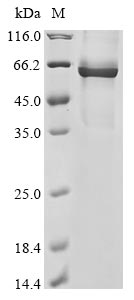Recombinant Human coronavirus OC43 Nucleoprotein (N) is produced in a mammalian expression system, which appears to ensure proper folding and post-translational modifications. This full-length protein covers amino acids 1 to 448 and includes an N-terminal 10xHis-tag and a C-terminal Myc-tag that help with purification and detection. SDS-PAGE analysis confirms the protein shows purity levels greater than 85%, making it suitable for various research applications.
The nucleoprotein (N) of Human coronavirus OC43 plays a crucial role in the virus's life cycle. It's primarily involved in viral RNA encapsidation and appears essential for nucleocapsid assembly and stability. This protein also seems to act as a key regulator of viral replication and transcription. Understanding how this protein works may be vital for research into coronavirus biology and potential therapeutic strategies.
Potential Applications
Note: The applications listed below are based on what we know about this protein's biological functions, published research, and experience from experts in the field. However, we haven't fully tested all of these applications ourselves yet. We'd recommend running some preliminary tests first to make sure they work for your specific research goals.
The protein is expressed in a mammalian system, which supports native-like eukaryotic folding and post-translational modifications (PTMs)—critical for the full-length HCoV-OC43 nucleoprotein (N) to interact with viral RNA and host factors. The N-terminal 10xHis and C-terminal Myc tags are minimally disruptive to structure, and full-length expression preserves all potential functional domains. However, no direct validation of folding (e.g., circular dichroism for secondary structure, thermal shift assays for stability) or bioactivity (e.g., RNA binding affinity, oligomerization, or host protein interactions) is provided. While mammalian expression strongly suggests correct folding, bioactivity remains unconfirmed—this limits definitive claims about its native functionality.
1. Antibody Development and Validation
This full-length recombinant HCoV-OC43 N protein can serve as an immunogen for generating monoclonal/polyclonal antibodies, and the dual tags simplify purification/detection. However, antibody specificity must be validated against native N—mammalian expression preserves conformational epitopes, but tag presentation may alter antigenicity, leading to cross-reactivity with non-native targets. ELISA can screen for affinity, but validation with native protein or infected cells is critical.
2. Protein-Protein Interaction Studies
Pull-down assays using the His/Myc tags can identify host interactors, but results depend on correct folding—mammalian expression improves native folding, but interactions must be validated via co-IP or functional assays to rule out artifacts from misfolding. The full length preserves all potential domains, but bioactivity (e.g., RNA binding) is unconfirmed.
3. Biochemical Characterization and Structural Studies
This protein supports biochemical assays (e.g., thermal stability, oligomerization) and structural studies (e.g., crystallography, cryo-EM). Mammalian expression ensures native-like structure, but the C-terminal Myc tag may interfere with crystallization—tag cleavage (via protease) may improve resolution. RNA binding and nucleocapsid assembly must be validated experimentally.
4. Immunoassay Development and Optimization
The dual-tagged N protein is a useful immunoassay standard, but its native conformation must be confirmed—the tags enable consistent detection, but assay performance (sensitivity/specificity) may differ if the protein misfolds. Validate with native N or clinical samples to ensure relevance to HCoV-OC43 biology.
5. Comparative Coronavirus Research
This mammalian-expressed N protein enables cross-reactivity studies with other coronavirus N proteins, as standardized folding reduces variability. However, PTMs may differ slightly between species—results should be contextualized, and direct comparisons (e.g., antibody cross-reactivity) must account for evolutionary divergence.
Final Recommendation & Action Plan
This mammalian-expressed, full-length HCoV-OC43 N protein is a strong candidate for antibody development, immunoassays, and comparative research due to its native-like folding. Prioritize validation of folding (CD/thermal shift) and bioactivity (RNA binding/oligomerization) to ensure reliability. For interactions or structural studies, use tag cleavage if needed and pair with co-IP/functional assays. If validation passes, leverage its consistency for downstream applications—always include native N controls to contextualize results. If folding/bioactivity fails, optimize expression (e.g., co-express chaperones) or use a viral replication system to produce native protein.






